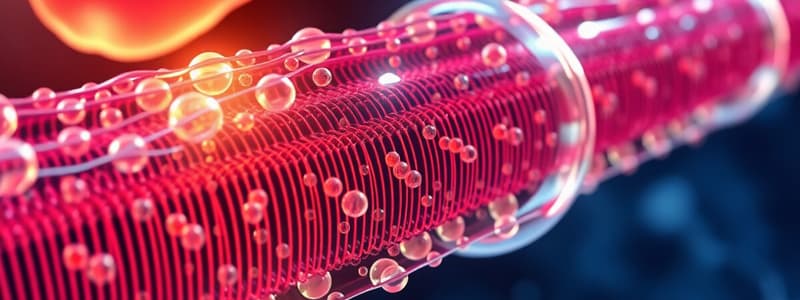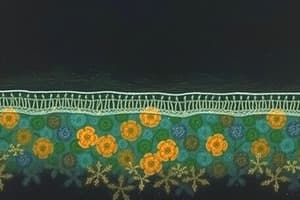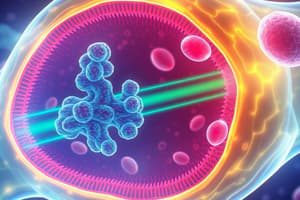Podcast
Questions and Answers
Why do cells maintain ion concentration gradients across their membranes?
Why do cells maintain ion concentration gradients across their membranes?
- To maintain a neutral membrane potential, ensuring no charge difference exists.
- To prevent the accumulation of excess charges that could lead to cellular disruption. (correct)
- To ensure an equal distribution of water-soluble molecules on both sides of the membrane.
- To facilitate the passive diffusion of charged molecules into the cell.
How does the rate of passive transport for non-electrolytes relate to their partition coefficient and size?
How does the rate of passive transport for non-electrolytes relate to their partition coefficient and size?
- Rate decreases with increasing partition coefficient, and larger molecules diffuse faster.
- Rate is independent of partition coefficient; size is the only determining factor.
- Rate increases with decreasing partition coefficient, and smaller molecules diffuse slower.
- Rate increases with increasing partition coefficient, and smaller molecules diffuse faster. (correct)
What determines the direction of transport in passive diffusion?
What determines the direction of transport in passive diffusion?
- The molecule's affinity for the membrane protein.
- The concentration gradient. (correct)
- The presence of ATP.
- The charge of the molecule.
What is the primary distinction between passive and active transport mechanisms?
What is the primary distinction between passive and active transport mechanisms?
What role do transport proteins play in facilitated diffusion, and what characteristics of molecules typically require this mechanism?
What role do transport proteins play in facilitated diffusion, and what characteristics of molecules typically require this mechanism?
Which of the following statements best characterizes the function of ATP-powered pumps?
Which of the following statements best characterizes the function of ATP-powered pumps?
What distinguishes channel proteins from carrier proteins in membrane transport?
What distinguishes channel proteins from carrier proteins in membrane transport?
Considering the properties of artificial lipid bilayers, which substances would most easily permeate the membrane?
Considering the properties of artificial lipid bilayers, which substances would most easily permeate the membrane?
In the context of membrane transport, what does the term "membrane potential" refer to?
In the context of membrane transport, what does the term "membrane potential" refer to?
Which statement accurately describes how the composition of transport proteins varies across different cellular membranes?
Which statement accurately describes how the composition of transport proteins varies across different cellular membranes?
How do excesses of positive and negative charges contribute to the formation of membrane potential?
How do excesses of positive and negative charges contribute to the formation of membrane potential?
Considering the sodium/potassium pump, where does it fit into membrane transport mechanisms?
Considering the sodium/potassium pump, where does it fit into membrane transport mechanisms?
Which factor primarily dictates the ability of a molecule to passively cross a membrane?
Which factor primarily dictates the ability of a molecule to passively cross a membrane?
What is the functional implication of the membrane potential in a cell?
What is the functional implication of the membrane potential in a cell?
How do transport proteins contribute to the selective permeability of cellular membranes?
How do transport proteins contribute to the selective permeability of cellular membranes?
What adaptation do cells utilize to balance an overwhelmingly positive external charge (Na+)?
What adaptation do cells utilize to balance an overwhelmingly positive external charge (Na+)?
Given that the positive internal charge (K+) is balanced by nucleic acids and proteins, what implication does this electrical balance have on membrane potential?
Given that the positive internal charge (K+) is balanced by nucleic acids and proteins, what implication does this electrical balance have on membrane potential?
How does the action of specific transporters directly influence the ion gradients across the cell membrane?
How does the action of specific transporters directly influence the ion gradients across the cell membrane?
Considering the transport rate of various transport mechanisms, what is the order (fastest to slowest)?
Considering the transport rate of various transport mechanisms, what is the order (fastest to slowest)?
Which factor differentiates the transport mechanism of channel proteins from that of carrier proteins?
Which factor differentiates the transport mechanism of channel proteins from that of carrier proteins?
Given that the rate of passive transport is dependent on the partition coefficient, how does this influence drug design?
Given that the rate of passive transport is dependent on the partition coefficient, how does this influence drug design?
How does facilitated diffusion differ fundamentally from simple diffusion?
How does facilitated diffusion differ fundamentally from simple diffusion?
What is the significance of having different sets of transport proteins in the membranes of various organelles and the plasma membrane?
What is the significance of having different sets of transport proteins in the membranes of various organelles and the plasma membrane?
How does the cell membrane potential fundamentally influence the physiology of excitable cells such as neurons?
How does the cell membrane potential fundamentally influence the physiology of excitable cells such as neurons?
Flashcards
Membrane Permeability
Membrane Permeability
The tendency of a substance to pass through a membrane; smaller and more permeable substances cross more easily.
Membrane Permeability Differences
Membrane Permeability Differences
Lipid bilayers are impermeable to large, uncharged polar molecules and ions. Cell membranes are permeable to these.
Membrane Transport Proteins
Membrane Transport Proteins
Proteins in the membrane, that mediate the transfer of water-soluble molecules across the membrane.
Membrane Transport Specificity
Membrane Transport Specificity
Signup and view all the flashcards
Membrane Potential
Membrane Potential
Signup and view all the flashcards
Passive Transport
Passive Transport
Signup and view all the flashcards
Active Transport
Active Transport
Signup and view all the flashcards
Partition Coefficient
Partition Coefficient
Signup and view all the flashcards
Facilitated Diffusion
Facilitated Diffusion
Signup and view all the flashcards
ATP-Powered Pump
ATP-Powered Pump
Signup and view all the flashcards
Channel Protein
Channel Protein
Signup and view all the flashcards
Carrier Protein
Carrier Protein
Signup and view all the flashcards
Study Notes
- Artificial membranes are not equally permeable to all substances
- The smaller and more permeable a substance, the more likely it is to cross the membrane
- Synthetic lipid bilayers are impermeable to large uncharged polar molecules (e.g. some amino acids, glucose and nucleotides) and charged molecules (ions)
- Cell membranes are permeable to large uncharged polar molecules and charged molecules
- Transfer of water-soluble molecules depends on membrane transport proteins
- Each transport protein transfers a particular type of molecule, allowing an uneven concentration of that molecule to build up on either side of the membrane
- The set of transport proteins in a membrane determines exactly what water-soluble molecules can pass into and out of that cell or organelle
- Each type of membrane has its own characteristic set of transport proteins
- Unbalanced ion concentration gradients can cause a cell to be torn apart by electrical forces
- The positive external charge (Na+) is largely balanced by anions (Cl-)
- The positive internal charge (K+) is balanced mainly by nucleic acids and proteins
- Excesses of positive and negative charges accumulate at the plasma membrane, giving rise to the membrane potential
- The inside of the cell membrane is negative, and the outside is positive
- Ion gradients are the result of specific transporters that move specific ions
Types of transport:
- Passive transport does not require external energy
- Passive transport requires a concentration gradient, where the molecule travels down its concentration gradient (from high concentration to low)
- Active transport requires energy
- Active transport transports molecules against their concentration gradient
Passive transport (diffusion):
- Gases (O2, CO2), hydrophobic molecules (benzene), and small polar uncharged molecules (H₂O, ethanol) can dissolve in the lipid bilayer
- These molecules diffuse across the lipid bilayer, and then dissolve in the aqueous solution on the other side of the membrane
- For non-electrolytes, the rate of passive transport (diffusion) is dependent upon its partition coefficient
- Partition coefficient is a measure of a molecule's ability to partition between aqueous and hydrophobic environments
- Size also determines the rate of diffusion
- Of 2 molecules of equal partition coefficient, the smaller one diffuses faster than the larger
- Direction of transport is only determined by the concentration gradient
- A molecule can move in either direction until equilibrium is reached
Passive transport (diffusion) with molecules that cannot dissolve in the lipid bilayer:
- Large polar uncharged molecules (amino acids, nucleotides and sugars) and charged molecules (ions) are unable to dissolve in the lipid bilayer
- During facilitated diffusion, the passage of polar and charged molecules is mediated by proteins that enable the transported molecules to cross the membrane without directly interacting with its hydrophobic interior
- Facilitated diffusion requires membrane proteins and a concentration gradient, but no energy
- The molecule can either interact with the membrane protein or not
Active transport:
- Active transport moves proteins against their concentration gradient
- Active transport requires a membrane transport protein that is coupled to an energy-consuming reaction (hydrolysis of ATP)
- Examples include the proton pump of the lysosome and the sodium/potassium pump of the plasma membrane
Classes of transport proteins:
- ATP-powered pumps transport 1-1000 molecules/sec
- Channel proteins (ions) transport 107-108 molecules/sec
- Carrier proteins (transporters) transport 102-104 molecules/sec
- Hydrolysis of ATP is coupled to the transport of a molecule against its concentration gradient
- Ions are transported down their concentrations gradient through a hydrophilic pore in the membrane protein
- Channel proteins exist in an open or closed conformation and when open, many ions can pass simultaneously
Studying That Suits You
Use AI to generate personalized quizzes and flashcards to suit your learning preferences.




